Snowfall Variation in Eastern Mediterranean Catchments
Abstract
:1. Introduction
2. Materials and Methods
2.1. Study Area
2.2. Global Land Data Assimilation System (GLDAS) Dataset
2.3. Methodology
3. Results
3.1. Comparison with In-Situ Data
3.2. Snow Mapping
- (i)
- Reading the GLDAS satellite dataset and selecting the region of interest;
- (ii)
- Date screening;
- (iii)
- Estimation of the spatial distribution of SWE and SD in the selected areas;
- (iv)
- Calculation of the snow density;
- (v)
- Mapping the snow parameters in the selected areas.
3.3. Temporal Variability of the Snow Parameters
4. Discussion
5. Conclusions
- (1)
- The 61-year record, based on the satellite analysis, resulted in increasing trends of snow water equivalent, due to the enhanced values between 2000 and 2013; however, decreasing trends starting from 2013 until now of −1.79 × 10−17 and −2.31 × 10−18 over the two representative areas of Greece (i.e., the Anthemountas and Mouriki basins). A similar SWE pattern is found for the study area in Italy, with a decreasing trend of −4.45 × 10−18 after 2010.
- (2)
- The SWE and SD annual cycle seems to be higher in the winter months and zero in the warmer months for the three study areas, whilst snow coverage is reported in September only for the Mouriki basin.
- (3)
- The mean snow density is calculated as equal to 224 kg/m3 for both the Anthemountas basin and the Upper Volturno-Calore basin, denoting the significance of the geographical characteristics (e.g., altitude) in each reference region, whilst the yearly mean snow density is differentiated for the two Greek study areas, with the area of the Mouriki basin presenting the lowest annual value (i.e., 206 kg/m3).
- (4)
- Overall, the present study evaluates and strengthens our limited understanding of the importance of the estimation of the spatial snow distribution in the Eastern Mediterranean which could be crucial for long-term groundwater management, by combining meteorological (i.e., snow data trends), hydrological, and satellite statistics. This information is crucial for representing distributions of the snow water equivalent, for examining the level of repetition from year-to-year, and for improving the water resource management.
Author Contributions
Funding
Data Availability Statement
Acknowledgments
Conflicts of Interest
References
- Sturm, M.; Taras, B.; Liston, G.E.; Derksen, C.; Jonas, T.; Lea, J. Estimating Snow Water Equivalent Using Snow Depth Data and Climate Classes. J. Hydrometeorol. 2010, 11, 1380–1394. [Google Scholar] [CrossRef]
- Wesemann, J.; Herrnegger, M.; Schulz, K. Hydrological modelling in the anthroposphere: Predicting local runoff in a heavily modified high-alpine catchment. J. Mt. Sci. 2018, 15, 921–938. [Google Scholar] [CrossRef] [Green Version]
- Pistocchi, A.; Bagli, S.; Callegari, M.; Notarnicola, C.; Mazzoli, P. On the Direct Calculation of Snow Water Balances Using Snow Cover Information. Water 2017, 9, 848. [Google Scholar] [CrossRef] [Green Version]
- Marty, C.; Meister, R. Long-term snow and weather observations at Weissfluhjoch and its relation to other high-altitude observatories in the Alps. Theor. Appl. Climatol. 2012, 110, 573–583. [Google Scholar] [CrossRef] [Green Version]
- Wang, X.; Xie, H.; Liang, T.; Huang, X. Comparison and validation of MODIS standard and new combination of Terra and Aqua snow cover products in northern Xinjiang, China. Hydrol. Process. 2009, 429, 419–429. [Google Scholar] [CrossRef]
- Wang, Y.; Huang, X.; Liang, H.; Sun, Y.; Feng, Q.; Liang, T. Tracking Snow Variations in the Northern Hemisphere Using Multi-Source Remote Sensing Data (2000–2015). Remote Sens. 2018, 10, 136. [Google Scholar] [CrossRef] [Green Version]
- Zhou, C.; Zheng, L. Mapping Radar Glacier Zones and Dry Snow Line in the Antarctic Peninsula Using Sentinel-1 Images. Remote Sens. 2017, 9, 1171. [Google Scholar] [CrossRef] [Green Version]
- Niu, H.W.; Kang, S.C.; Wang, H.L.; Du, J.K.; Pu, T.; Zhang, G.T.; Lu, X.X.; Yan, X.G.; Wang, S.J.; Shi, X.F. Light-absorbing impurities accelerating glacial melting in southeastern Tibetan Plateau. Environ. Pollut. 2020, 257, 113541. [Google Scholar] [CrossRef]
- Niu, H.; Kang, S.; Wang, H.; Zhang, R.; Lu, X.; Qian, Y.; Paudyal, R.; Wang, S.; Shi, X.; Yan, X. Seasonal variation and light absorption property of carbonaceous aerosol in a typical glacier region of the southeastern Tibetan Plateau. Atmos. Chem. Phys. 2018, 18, 6441–6460. [Google Scholar] [CrossRef] [Green Version]
- Fayad, A.; Gascoin, S.; Faour, G.; López-Moreno, J.I.; Drapeau, L.; Page, M.L.; Escadafal, R. Snow hydrology in Mediterranean mountain regions: A review. J. Hydrol. 2017, 551, 374–396. [Google Scholar] [CrossRef]
- Wang, S.; Russell, H.A.J. Forecasting Snowmelt-Induced Flooding Using GRACE Satellite Data: A Case Study for the Red River Watershed. Can. J. Remote Sens. 2016, 42, 203–213. [Google Scholar] [CrossRef]
- Adamowski, J.F. Development of a short-term river flood forecasting method for snowmelt driven floods based on wavelet and cross-wavelet analysis. J. Hydrol. 2008, 353, 247–266. [Google Scholar] [CrossRef]
- Baggi, S.; Schweizer, J. Characteristics of wet snow avalanche activity: 20 years of observations from a high alpine valley (Dischma, Switzerland). Nat. Hazards 2009, 50, 97–108. [Google Scholar] [CrossRef] [Green Version]
- Grusson, Y.; Sun, X.; Gascoin, S.; Sauvage, S.; Raghavan, S.; Anctil, F.; Sáchez-Pérez, J.-M. Assessing the capability of the SWAT model to simulate snow, snow melt and treamflow dynamics over an alpine watershed. J. Hydrol. 2015, 531, 574–588. [Google Scholar] [CrossRef]
- Myers, D.T.; Ficklin, D.L.; Robeson, S.M. Incorporating rain-on-snow into the SWAT model results in more accurate simulations of hydrologic extremes. J. Hydrol. 2021, 603, 126972. [Google Scholar] [CrossRef]
- Okkonen, J.; Kløve, B. A sequential modelling approach to assess groundwater–surface water resources in a snow dominated region of Finland. J. Hydrol. 2011, 411, 91–107. [Google Scholar] [CrossRef]
- Sorman, A.A.; Sensoy, A.; Tekeli, A.E.; Sorman, A.U.; Akyurek, Z. Modelling and forecasting snowmelt runoff process using the HBV model in the eastern part of Turkey. Hydrol. Process 2009, 23, 1031–1040. [Google Scholar] [CrossRef]
- Lee, J.; Jung, H. Understanding the relationship between meltwater discharge and solute concentration by modeling solute transport in a snowpack in snow-dominated regions—A review. Polar Sci. 2022, 31, 100782. [Google Scholar] [CrossRef]
- Stefanidis, S.; Stathis, D.; Dafis, S. The characteristics of snowfall in the mountainous areas of Trikala region. In Proceedings of the 19th Forestry Conference, Litochoro, Greece, 5 October 2019. [Google Scholar]
- Kazakis, N.; Pavlou, A.; Vargemezis, G.; Voudouris, K.; Soulios, G.; Pliakas, F.; Tsokas, G. Seawater intrusion mapping using electrical resistivity tomography and hydrochemical data. An application in the coastal area of eastern Thermaikos Gulf, Greece. Sci. Total Environ. 2016, 543, 373–387. [Google Scholar] [CrossRef]
- Patrikaki, O.; Kazakis, N.; Voudouris, K. Vulnerability map: A useful tool for groundwater protection: An example from Mouriki basin, North Greece. Fresenius Environ. Bull. 2012, 21, 2516–2521. [Google Scholar]
- Ntona, M.M.; Busico, G.; Mastroccico, M.; Kazakis, N. The impacts of drought on groundwater resources in the Upper Volturno basin, Southern Italy. In Proceedings of the 16th International Congress of Geological Society of Greece, Patra, Greece, 17–19 October 2022. [Google Scholar]
- Busico, G.; Kazakis, N.; Colombani, N.; Mastrocicco, M.; Voudouris, K.; Tedesco, D. A modified SINTACS method for groundwater vulnerability and pollution risk assessment in highly anthropized regions based on NO3− and SO42− concentrations. Sci. Total Environ. 2017, 609, 1512–1523. [Google Scholar] [CrossRef] [PubMed]
- Rodell, M.; Houser, P.R.; Jambor, U.; Gottschalck, J.; Mitchell, K.; Meng, C.J.; Arsenault, K.; Cosgrove, B.; Radakovich, J.; Bosilovich, M.; et al. The Global Land Data Assimilation System. Bull. Am. Meteorol. Soc. 2004, 85, 381–394. [Google Scholar] [CrossRef] [Green Version]
- Meløysund, V.; Leira, B.; Høiseth, K.; Lisø, K. Predicting snow density using meteorological data. Meteorological Applications. 2007, 14, 413–423. [Google Scholar] [CrossRef]
- Dumanski, S.; Pomeroy, J.W.; Westbrook, C.J. Hydrological regime changes in a Canadian Prairie basin. Hydrol. Process. 2015, 29, 3893–3904. [Google Scholar] [CrossRef]
- Carroll, R.W.H.; Deems, J.S.; Niswonger, R.; Schumer, R.; Williams, K.H. The Importance of Interflow to Groundwater Recharge in a Snowmelt-Dominated Headwater Basin. Geophys. Res. Lett. 2019, 46, 5899–5908. [Google Scholar] [CrossRef] [Green Version]
- Houssos, E.E.; Lolis, C.J.; Bartzokas, A. The atmospheric conditions over Europe and the Mediterranean, favoring snow events in Athens, Greece. Adv. Geosci. 2007, 12, 127–135. [Google Scholar] [CrossRef] [Green Version]
- Dafis, S.; Lolis, C.J.; Houssos, E.E.; Bartzokas, A. The atmospheric circulation characteristics favouring snowfall in an area with complex relief in Northwestern Greece. Int. J. Climatol. 2016, 36, 3561–3577. [Google Scholar] [CrossRef]
- Leivathinos, A.Ν. The phenomenon of snowfall in Greece. Proc. Athens Acad. 1936, 11, 116–131. [Google Scholar]
- Capozzi, V.; De Vivo, C.; Budillon, G. Synoptic control over winter snowfall variability observed in a remote site of Apennine Mountains (Italy), 1884–2015. Cryosphere 2022, 16, 1741–1763. [Google Scholar] [CrossRef]
- Kazakis, N.; Voudouris, K.; Koumantakis, I. Groundwater depletion in Anthemountas basin. Climate change or Mis-management? In Proceedings of the 3rd Conference of ΕΥΕ-ΕΕDYP-ΕΥS, Athens, Greece, 10–12 December 2015; pp. 199–206. [Google Scholar]
- Jafarov, E.E.; Coon, E.T.; Harp, D.R.; Wilson, C.J.; Painter, S.L.; Atchley, A.L.; Romanovsky, V.E. Modeling the role of preferential snow accumulation in through talik development and hillslope groundwater flow in a transitional permafrost landscape. Environ. Res. Lett. 2018, 13, 105006. [Google Scholar] [CrossRef]
- Ntona, M.M.; Busico, G.; Mastrocicco, M.; Kazakis, N. Modeling groundwater and surface water interaction: An overview of current status and future challenges. Sci. Total Environ. 2022, 846, 157355. [Google Scholar] [CrossRef] [PubMed]
- Gelfan, A.; Moreydo, V.; Motovilov, Y.; Solomatine, D.P. Long-term ensemble forecast of snowmelt inflow into the Cheboksary Reservoir under two different weather scenarios. Hydrol. Earth Syst. Sci. 2018, 22, 2073–2089. [Google Scholar] [CrossRef] [Green Version]
- Gleick, P.H. The development and testing of a water balance model for climate impact assessment: Modeling the Sacramento basin. Water Resour. Res. 1987, 23, 1049–1061. [Google Scholar] [CrossRef]
- Zhang, Z.; Li, Y.; Barlage, M.; Chen, F.; Miguez-Macho, G.; Ireson, A.; Li, Z. Modeling groundwater responses to climate change in the Prairie Pothole Region. Hydrol. Earth Syst. Sci. 2020, 24, 655–672. [Google Scholar] [CrossRef] [Green Version]
- Wagner, A.M.; Bennett, K.E.; Liston, G.E.; Hiemstra, C.A.; Cooley, D. Multiple Indicators of Extreme Changes in Snow-Dominated Streamflow Regimes, Yakima River Basin Region, USA. Water 2021, 13, 2608. [Google Scholar] [CrossRef]
- Gafurov, A.; Bárdossy, A. Cloud removal methodology from MODIS snow cover product. Hydrol. Earth Syst. Sci. 2009, 13, 1361–1373. [Google Scholar] [CrossRef] [Green Version]
- Foppa, N.; Seiz, G. Inter-annual variations of snow days over Switzerland from 2000–2010 derived from MODIS satellite data. Cryosphere 2012, 6, 331–342. [Google Scholar] [CrossRef] [Green Version]
- Hüsler, F.; Jonas, T.; Riffler, M.; Musial, J.P.; Wunderle, S. A satellite-based snow cover climatology (1985–2011) for the European Alps derived from AVHRR data. Cryosphere 2014, 8, 73–90. [Google Scholar] [CrossRef] [Green Version]
- Scherrer, S.C.; Wüthrich, C.; Croci-Maspoli, M.; Weingartner, R.; Appenzeller, C. Snow variability in the Swiss Alps 1864–2009. Int. J. Climatol. 2013, 33, 3162–3173. [Google Scholar] [CrossRef] [Green Version]
- Notarnicola, C. Overall negative trends for snow cover extent and duration in global mountain regions over 1982–2020. Sci. Rep. 2022, 12, 13731. [Google Scholar] [CrossRef]
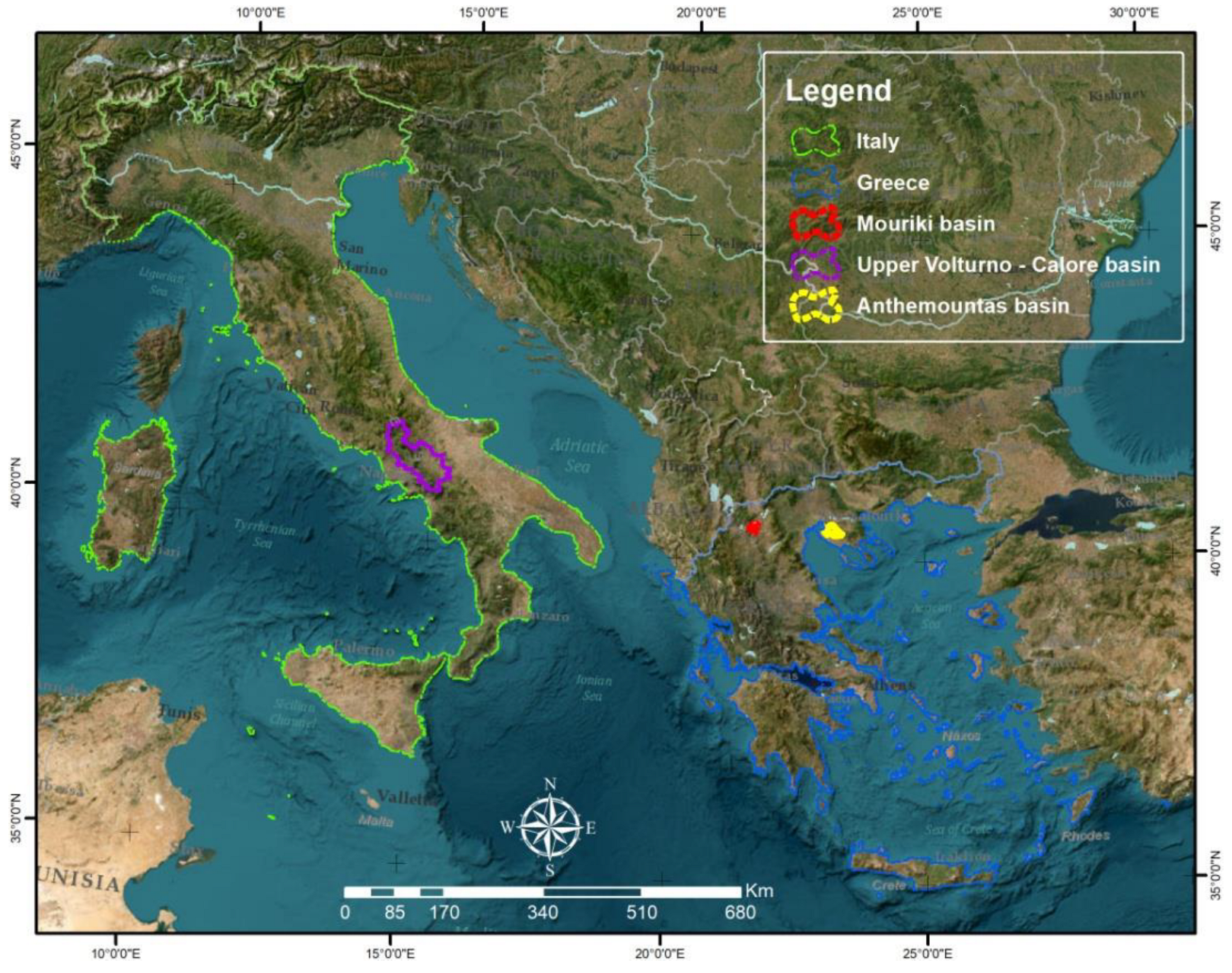
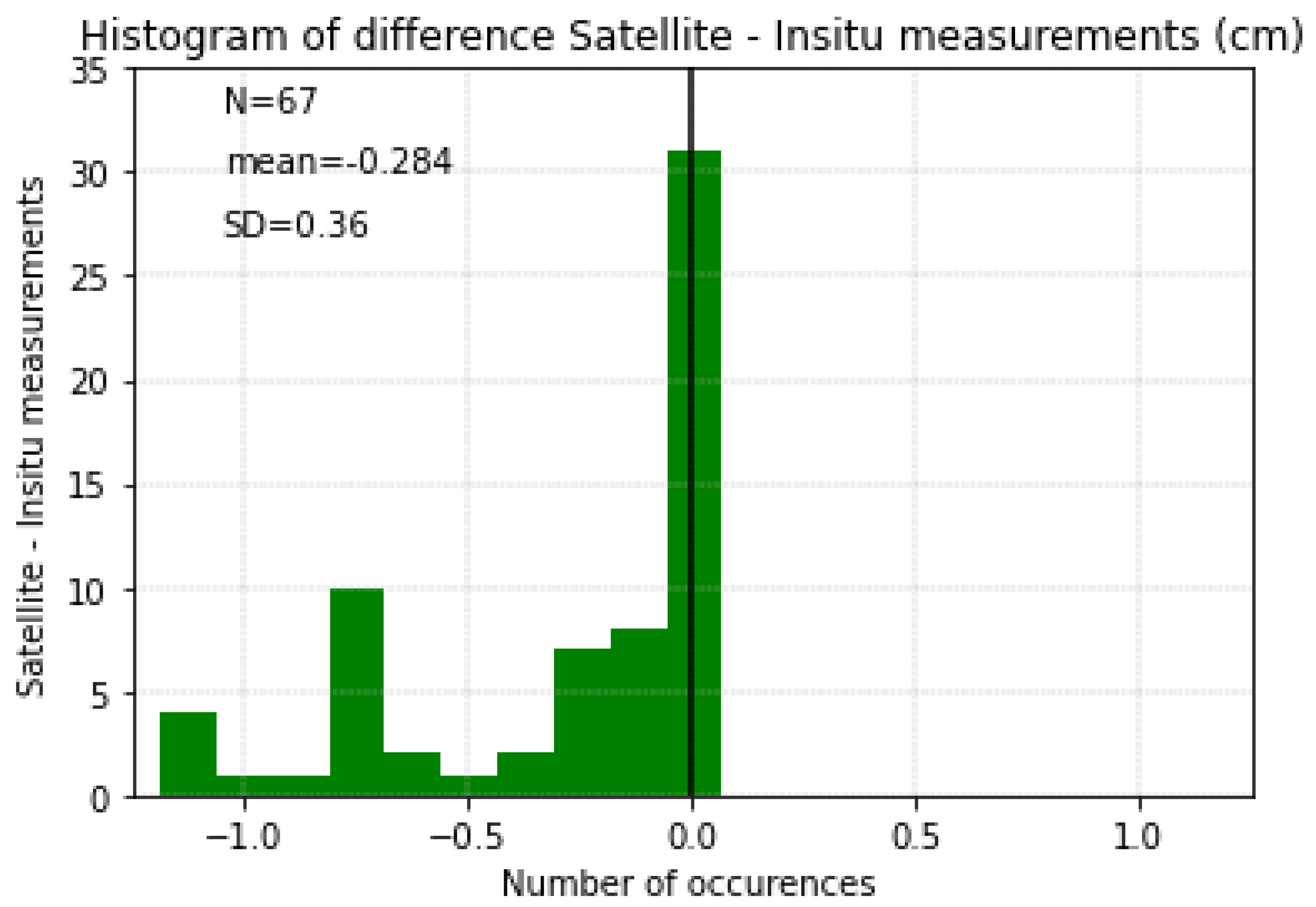
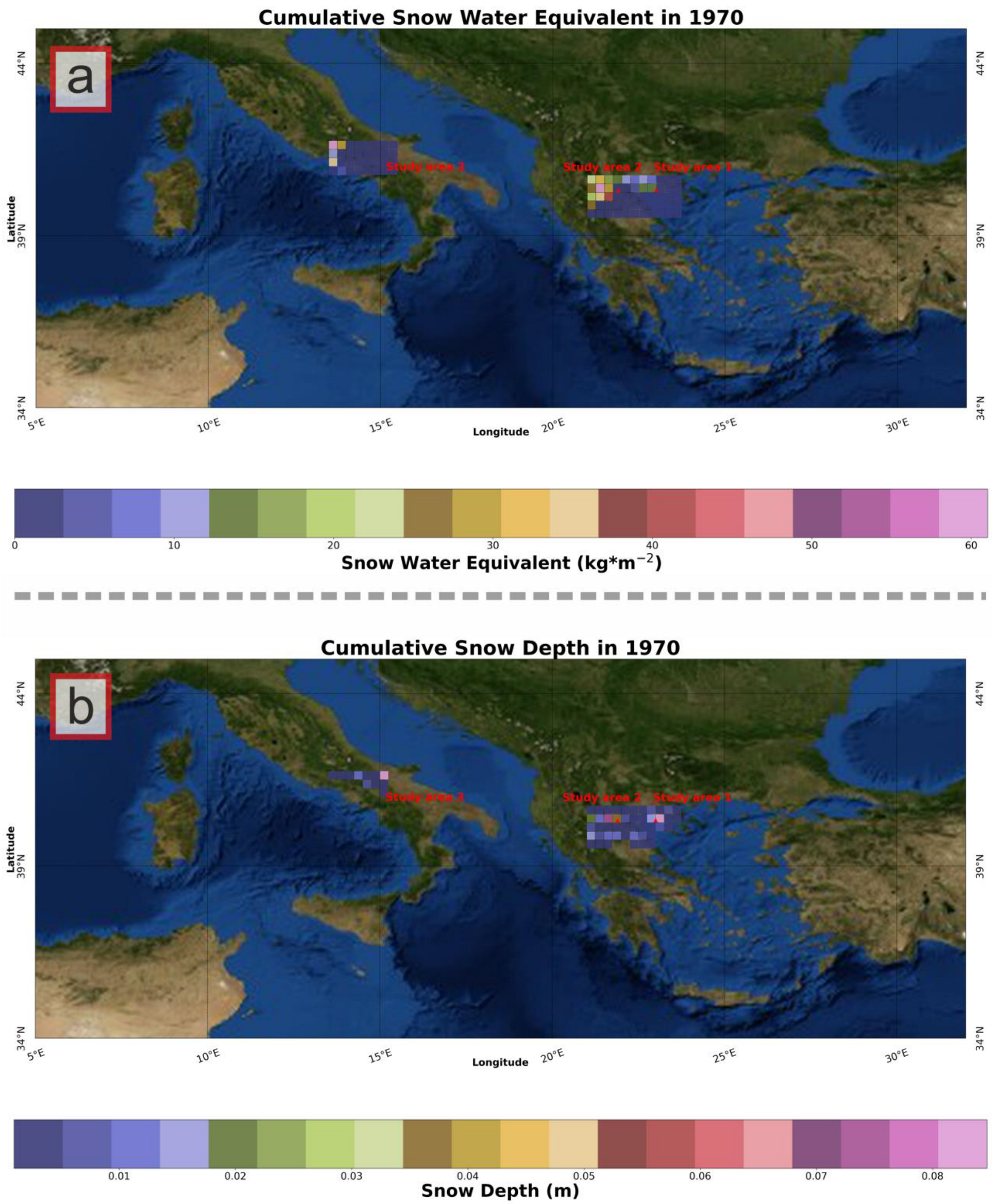
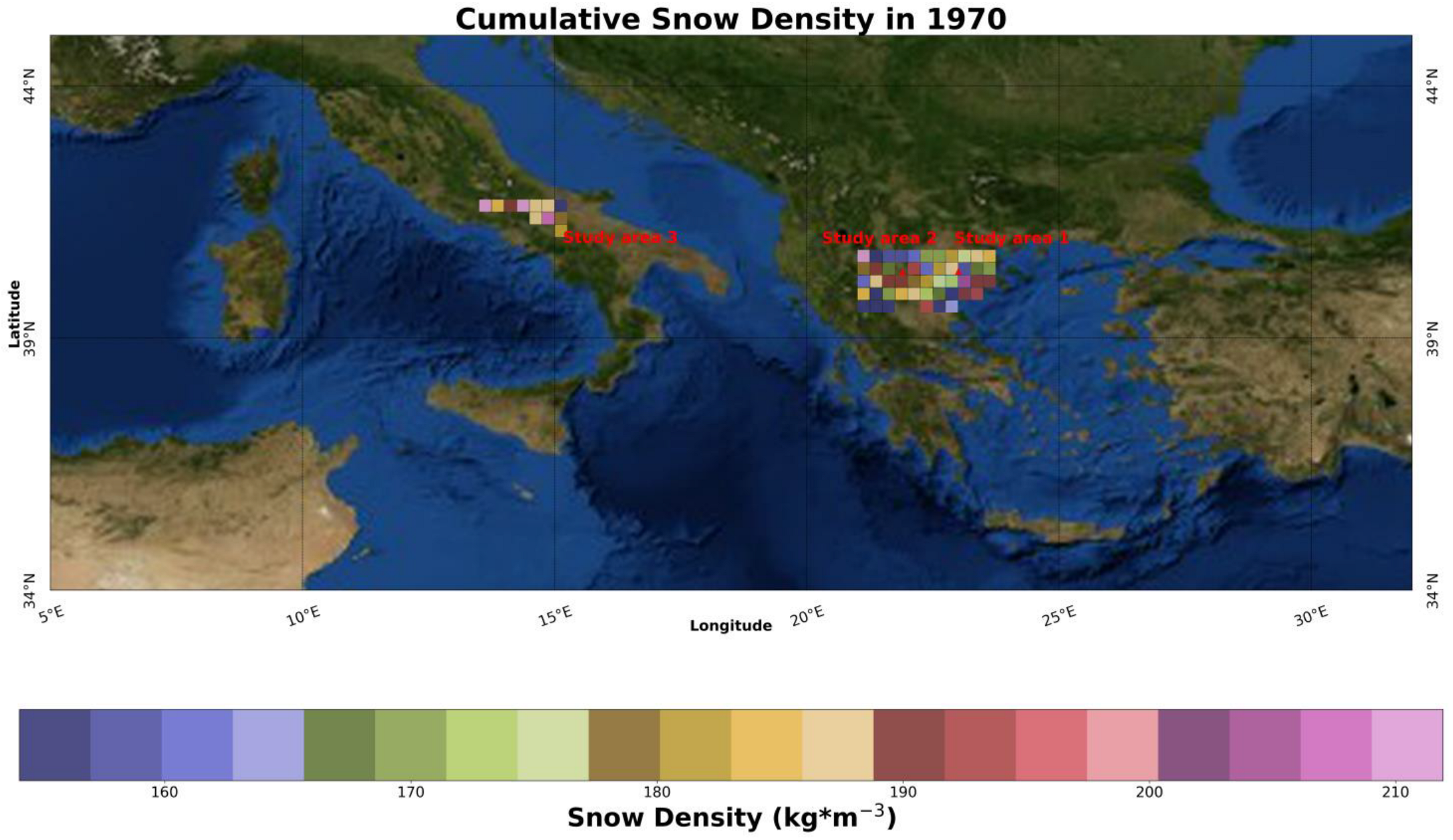


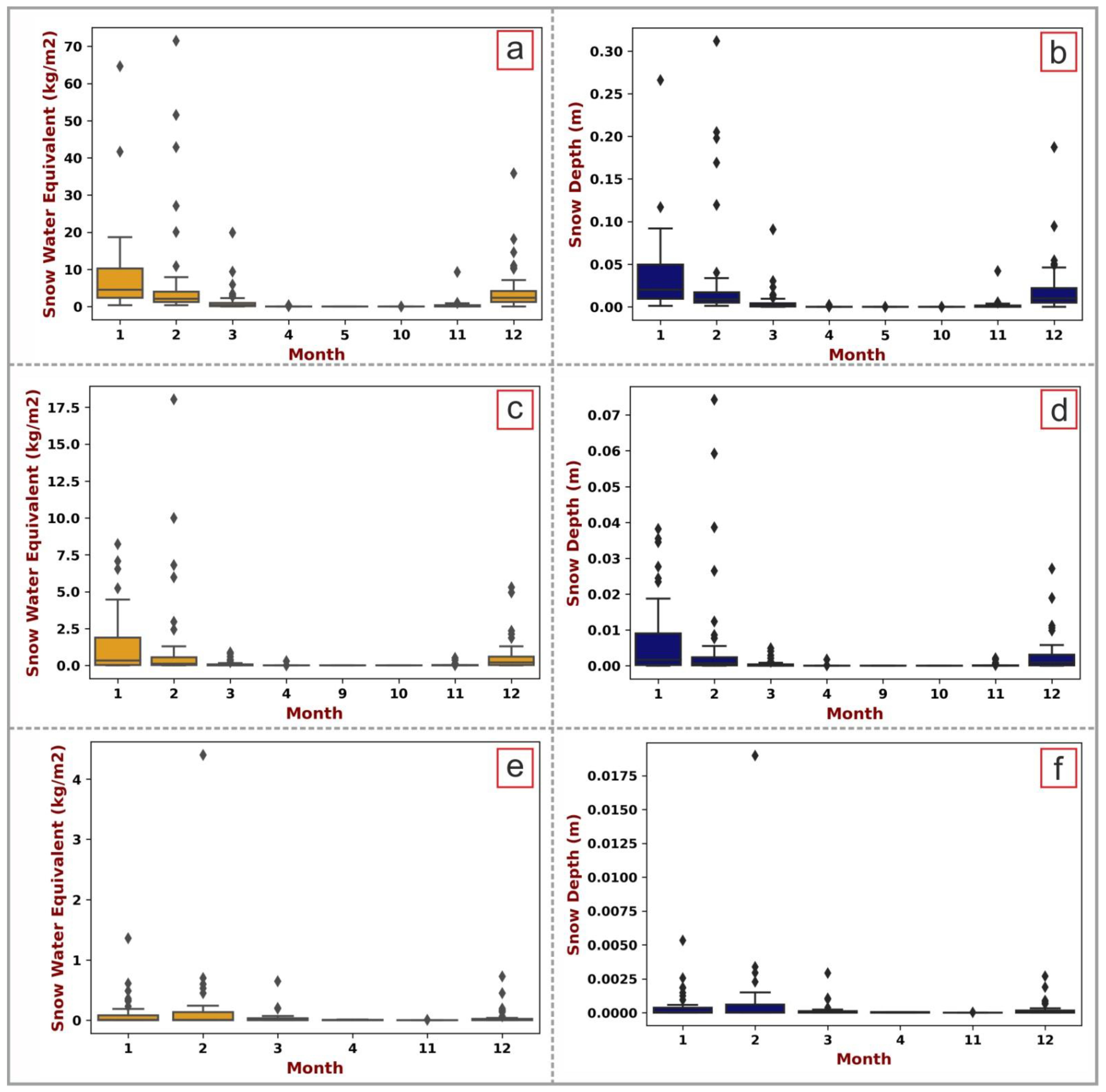
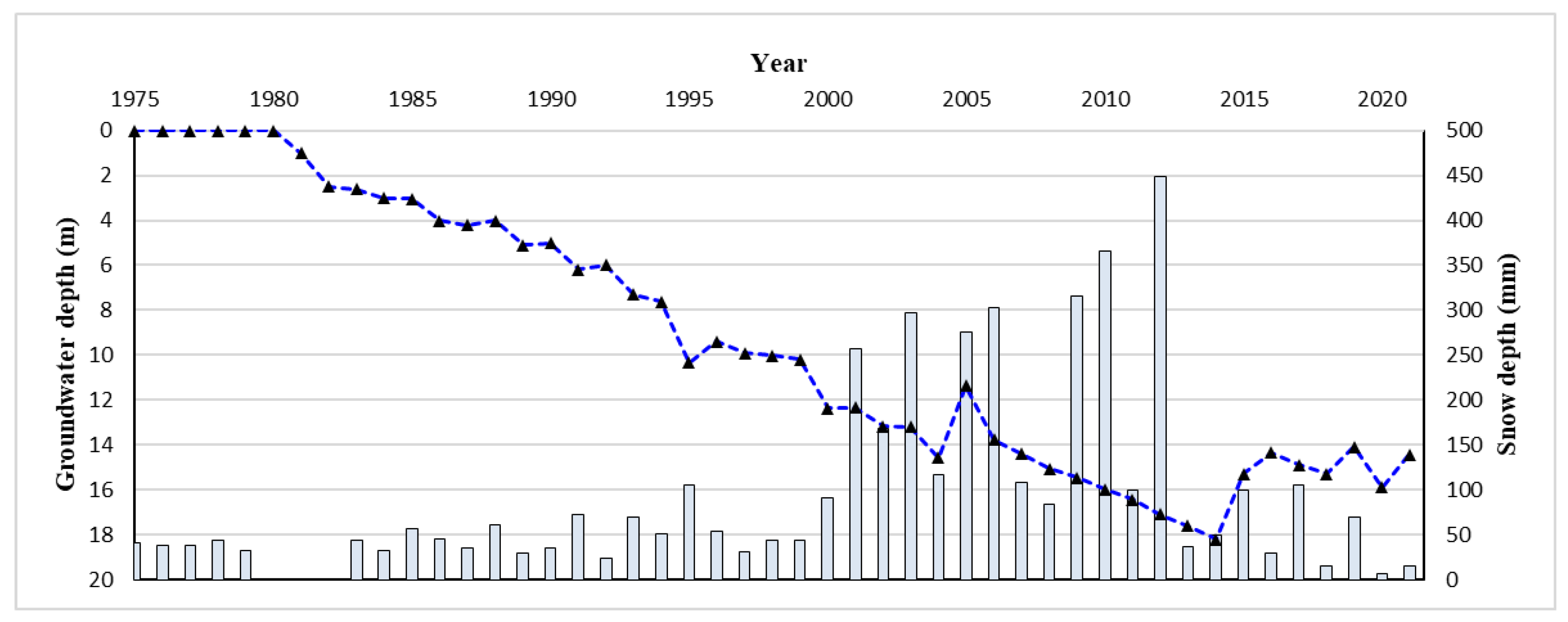
| Meteorological Station | Thessaloniki (Mount Athos) | Kozani (ZoodochosPigi) |
|---|---|---|
| Latitude | 40.320 | 40.375 |
| Longitude | 22.590 | 21.875 |
| Altitude (m) | 7 | 1303 |
| Study Area | Anthemountas Basin | Mouriki Basin | Upper Volturno-Calore Basin |
|---|---|---|---|
| Snow water equivalent (kg/m2) | 18.612 | 2.796 | 0.264 |
| Snow depth (m) | 0.083 | 0.0136 | 0.0012 |
| Snow density (kg/m3) | 224 | 206 | 224 |
| Season | Anthemountas Basin | Mouriki Basin | Upper Volturno-Calore Basin |
|---|---|---|---|
| Winter | 0.08 | 0.004711 | 0.0005 |
| Spring | 0.005385 | 0.0003 | 0.00011 |
| Summer | - | - | - |
| Autumn | 0.001795 | 0.00007 | 0.000008 |
Disclaimer/Publisher’s Note: The statements, opinions and data contained in all publications are solely those of the individual author(s) and contributor(s) and not of MDPI and/or the editor(s). MDPI and/or the editor(s) disclaim responsibility for any injury to people or property resulting from any ideas, methods, instructions or products referred to in the content. |
© 2023 by the authors. Licensee MDPI, Basel, Switzerland. This article is an open access article distributed under the terms and conditions of the Creative Commons Attribution (CC BY) license (https://creativecommons.org/licenses/by/4.0/).
Share and Cite
Voudouri, K.A.; Ntona, M.M.; Kazakis, N. Snowfall Variation in Eastern Mediterranean Catchments. Remote Sens. 2023, 15, 1596. https://doi.org/10.3390/rs15061596
Voudouri KA, Ntona MM, Kazakis N. Snowfall Variation in Eastern Mediterranean Catchments. Remote Sensing. 2023; 15(6):1596. https://doi.org/10.3390/rs15061596
Chicago/Turabian StyleVoudouri, Kalliopi Artemis, Maria Margarita Ntona, and Nerantzis Kazakis. 2023. "Snowfall Variation in Eastern Mediterranean Catchments" Remote Sensing 15, no. 6: 1596. https://doi.org/10.3390/rs15061596







